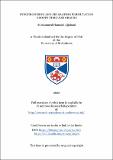Files in this item
Synchronising and separating permutation groups through graphs
Item metadata
| dc.contributor.advisor | Cameron, Peter J. (Peter Jephson) | |
| dc.contributor.advisor | Michell, James David | |
| dc.contributor.author | Aljohani, Mohammed Hamoud | |
| dc.coverage.spatial | 227 | en_US |
| dc.date.accessioned | 2022-11-23T10:56:09Z | |
| dc.date.available | 2022-11-23T10:56:09Z | |
| dc.date.issued | 2022-06-14 | |
| dc.identifier.uri | https://hdl.handle.net/10023/26470 | |
| dc.description.abstract | About 15 years ago, Araújo, Arnold and Steinberg introduced the notion of synchronisation to the theory of finite permutation groups. Synchronisation property is closely related to another property which is called separation, but they are not the same. Interestingly, the study of the two properties for finite groups involves many combinatorial problems. In this thesis, we tried to extend the current knowledge about synchronising and separating groups and suggest some questions. The introduction and the background are represented in Chapter 1 and Chapter 2, respectively. The main work is divided into three chapters. In Chapter 3, we started by extending the notions of synchronisation and separation to association schemes. Then, we considered two important families of almost simple permutation groups. Firstly, the group 𝐺 induced by the action of the symmetric group Sym(𝑛) on the set Ω of 𝑘-element subsets of an 𝑛-set, say {1, ..., 𝑛} (we call this the first group). Secondly, the group 𝐺 induced by the action of the symmetric group Sym(𝑛) on the set Ω of uniform 𝑙-partitions of an 𝑛-set, {1, ..., 𝑛}, into subsets of size 𝑘 where 𝑛 = 𝑘𝑙 (we call this the second group). For first group, when 𝑘 = 2, 3, 4 and 5, we showed that for large enough 𝑛 the group is non-separating (resp. non-synchronizing) if and only if there is a Steiner system S(𝑡, 𝑘, 𝑛) (resp. large set) for some 𝑡 < 𝑘. In general, we stated a conjecture that is if true would be a crucial extension of the remarkable result by Peter Keevash that considers the existence of Steiner systems. For the second group, we gave similar results to the first group when 𝐾 = 2, 3, 4, 5, 6 and 𝑙 = 2. We stated conjecture for 𝑘 > 6 and 𝑙 = 2. Also, we showed that the group is non-synchronising when 𝑙 > 2. In Chapter 4, the synchronisation property of a ne distance transitive permutation groups is considered. We showed that the separation and the synchronising properties are equivalent for a ne groups. We determined when some groups are synchronising, for example, automorphism groups of Hamming graphs, halved graphs, folded halved graphs, bilinear form graphs, some alternating form graphs and cosets graphs of some Golay codes. In addition, we stated a conjecture for distance regular graphs which connects this chapter and the previous one. In Chapter 5, we started by defining the diagonal factorisation of finite groups and proved some related basic results. Then, we showed that the diagonal group 𝐷(𝑇, 2) is non-separating if and only if 𝑇 admits a diagonal factorisation. Also, we showed that the group 𝐷(𝑇, 2) is non-separating when 𝑇 = 𝐴ₙ. We proved that the diagonal group 𝐷(𝑇, 𝑑) for 𝑑 ≥ 3, is non-synchronising. In the last section, we showed the equivalence between the separation and the synchronisation properties for groups of diagonal types. | en_US |
| dc.description.sponsorship | "This work was supported by the Ministry of Higher Education in Saudi Arabia (Taibah University) and the Saudi Cultural Bureau in London." -- Acknowledgements | en |
| dc.language.iso | en | en_US |
| dc.subject | Finite permutation groups | en_US |
| dc.subject | Synchronisation | en_US |
| dc.subject | Separation | en_US |
| dc.subject | Association schemes | en_US |
| dc.subject | Graphs | en_US |
| dc.subject.lcc | QA175.A6 | |
| dc.title | Synchronising and separating permutation groups through graphs | en_US |
| dc.type | Thesis | en_US |
| dc.contributor.sponsor | Saudi Arabia. Wizārat al-Taʻlīm al-ʻĀlī | en_US |
| dc.contributor.sponsor | Saudi Arabia. Safārah (London, England) | en_US |
| dc.type.qualificationlevel | Doctoral | en_US |
| dc.type.qualificationname | PhD Doctor of Philosophy | en_US |
| dc.publisher.institution | The University of St Andrews | en_US |
| dc.identifier.doi | https://doi.org/10.17630/sta/227 |
This item appears in the following Collection(s)
Items in the St Andrews Research Repository are protected by copyright, with all rights reserved, unless otherwise indicated.

